WHS Management System Report: Construction Industry in Australia
VerifiedAdded on 2020/04/01
|10
|2539
|92
Report
AI Summary
This report details the development of a Workplace Health & Safety Management System (WHSMS) tailored for a construction company operating in Australia. It begins by outlining the relevant WHS legislation, including the 2011 Work Health and Safety Act, WHS Regulations, and Codes of Practice, emphasizing the roles of Safe Work Australia. The report then constructs a WHSMS framework, encompassing a hierarchical structure and detailed job descriptions and qualifications for key personnel such as the Officer/Director, Workers, Health and Safety Representatives, and Supervisors/Inspectors. A financial budget is provided, detailing expenses such as salaries, electricity, rent, and insurance. Finally, the report addresses the communication of WHS policies, emphasizing consultation with workers and stakeholders, training programs for all site personnel, and the establishment of a Health and Safety Committee to ensure effective WHS management.
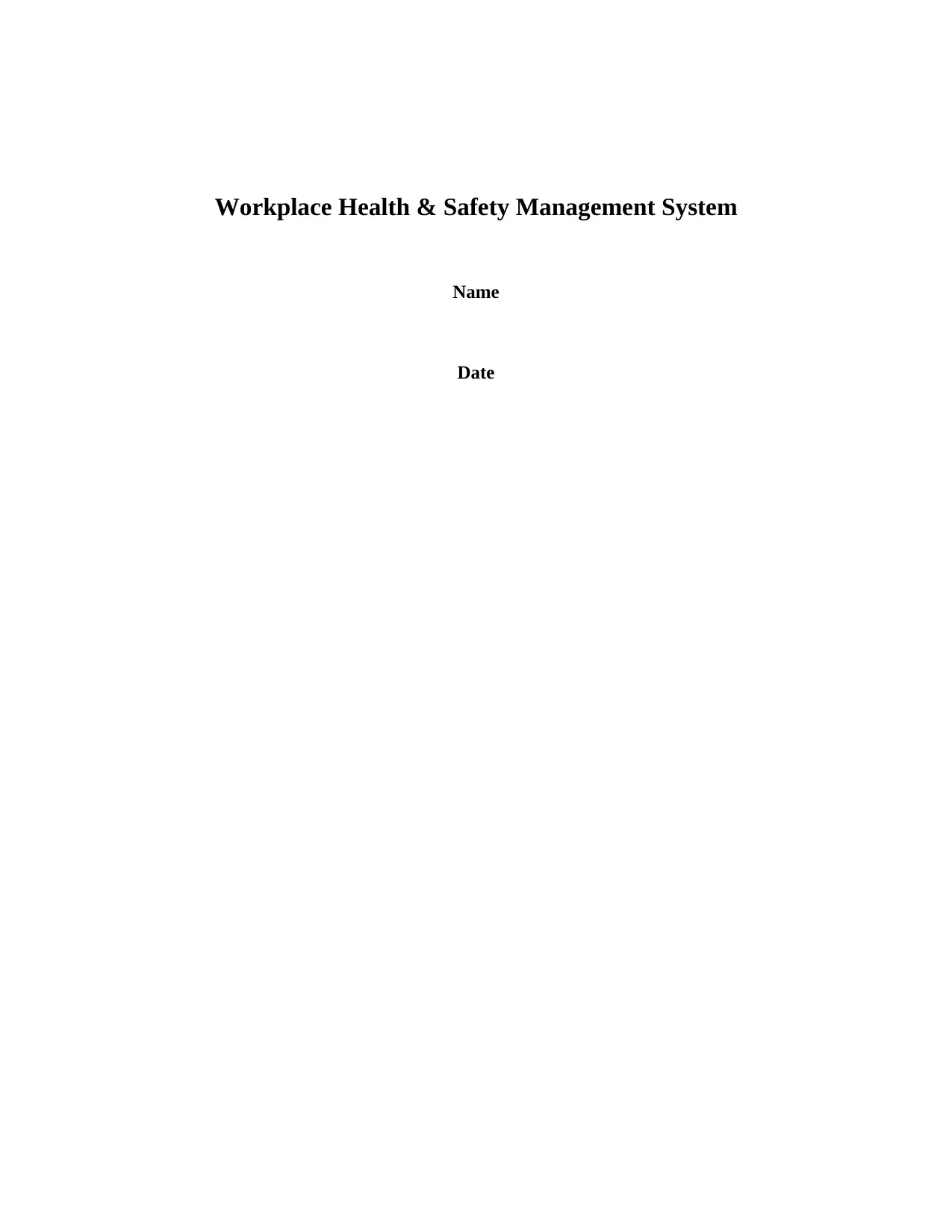
Workplace Health & Safety Management System
Name
Date
Name
Date
Paraphrase This Document
Need a fresh take? Get an instant paraphrase of this document with our AI Paraphraser
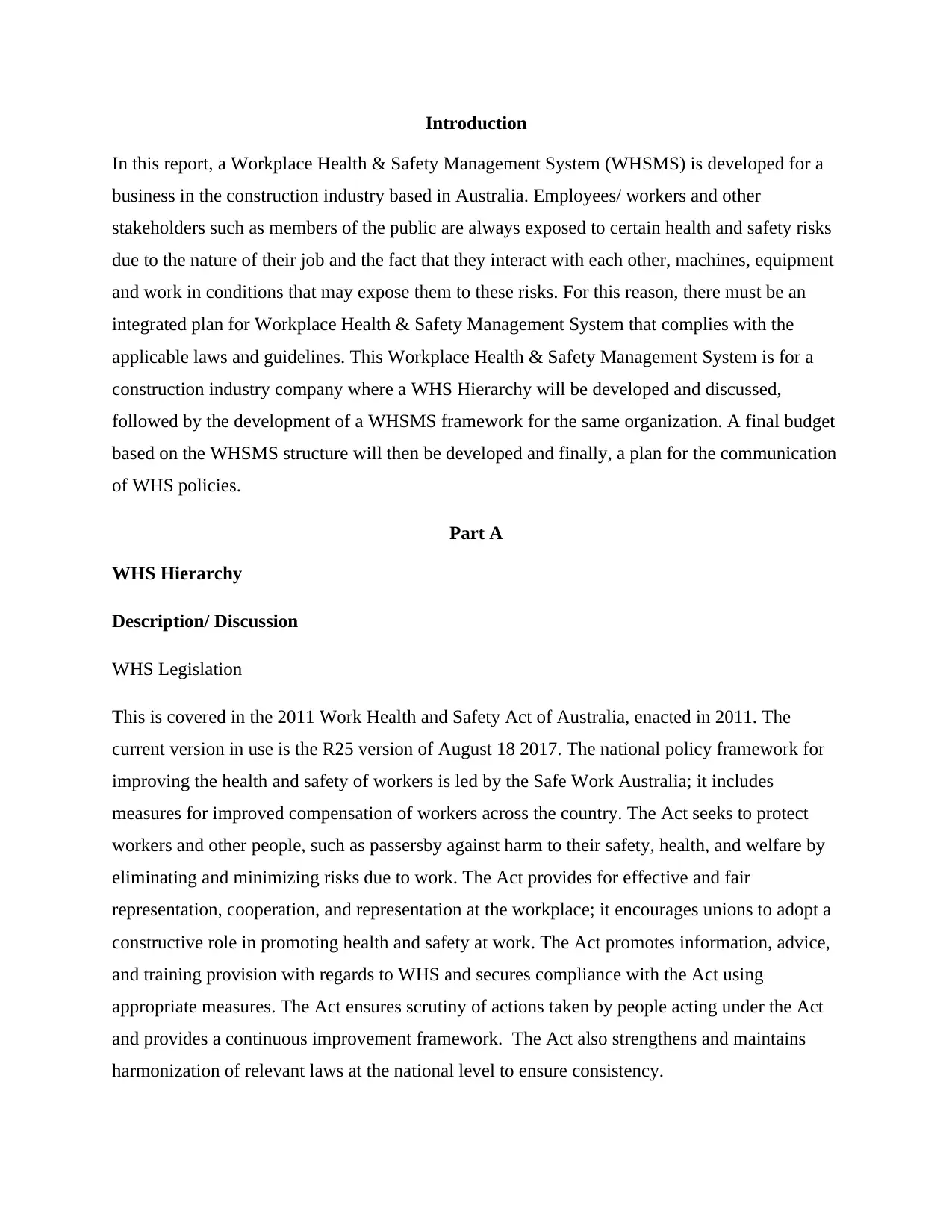
Introduction
In this report, a Workplace Health & Safety Management System (WHSMS) is developed for a
business in the construction industry based in Australia. Employees/ workers and other
stakeholders such as members of the public are always exposed to certain health and safety risks
due to the nature of their job and the fact that they interact with each other, machines, equipment
and work in conditions that may expose them to these risks. For this reason, there must be an
integrated plan for Workplace Health & Safety Management System that complies with the
applicable laws and guidelines. This Workplace Health & Safety Management System is for a
construction industry company where a WHS Hierarchy will be developed and discussed,
followed by the development of a WHSMS framework for the same organization. A final budget
based on the WHSMS structure will then be developed and finally, a plan for the communication
of WHS policies.
Part A
WHS Hierarchy
Description/ Discussion
WHS Legislation
This is covered in the 2011 Work Health and Safety Act of Australia, enacted in 2011. The
current version in use is the R25 version of August 18 2017. The national policy framework for
improving the health and safety of workers is led by the Safe Work Australia; it includes
measures for improved compensation of workers across the country. The Act seeks to protect
workers and other people, such as passersby against harm to their safety, health, and welfare by
eliminating and minimizing risks due to work. The Act provides for effective and fair
representation, cooperation, and representation at the workplace; it encourages unions to adopt a
constructive role in promoting health and safety at work. The Act promotes information, advice,
and training provision with regards to WHS and secures compliance with the Act using
appropriate measures. The Act ensures scrutiny of actions taken by people acting under the Act
and provides a continuous improvement framework. The Act also strengthens and maintains
harmonization of relevant laws at the national level to ensure consistency.
In this report, a Workplace Health & Safety Management System (WHSMS) is developed for a
business in the construction industry based in Australia. Employees/ workers and other
stakeholders such as members of the public are always exposed to certain health and safety risks
due to the nature of their job and the fact that they interact with each other, machines, equipment
and work in conditions that may expose them to these risks. For this reason, there must be an
integrated plan for Workplace Health & Safety Management System that complies with the
applicable laws and guidelines. This Workplace Health & Safety Management System is for a
construction industry company where a WHS Hierarchy will be developed and discussed,
followed by the development of a WHSMS framework for the same organization. A final budget
based on the WHSMS structure will then be developed and finally, a plan for the communication
of WHS policies.
Part A
WHS Hierarchy
Description/ Discussion
WHS Legislation
This is covered in the 2011 Work Health and Safety Act of Australia, enacted in 2011. The
current version in use is the R25 version of August 18 2017. The national policy framework for
improving the health and safety of workers is led by the Safe Work Australia; it includes
measures for improved compensation of workers across the country. The Act seeks to protect
workers and other people, such as passersby against harm to their safety, health, and welfare by
eliminating and minimizing risks due to work. The Act provides for effective and fair
representation, cooperation, and representation at the workplace; it encourages unions to adopt a
constructive role in promoting health and safety at work. The Act promotes information, advice,
and training provision with regards to WHS and secures compliance with the Act using
appropriate measures. The Act ensures scrutiny of actions taken by people acting under the Act
and provides a continuous improvement framework. The Act also strengthens and maintains
harmonization of relevant laws at the national level to ensure consistency.
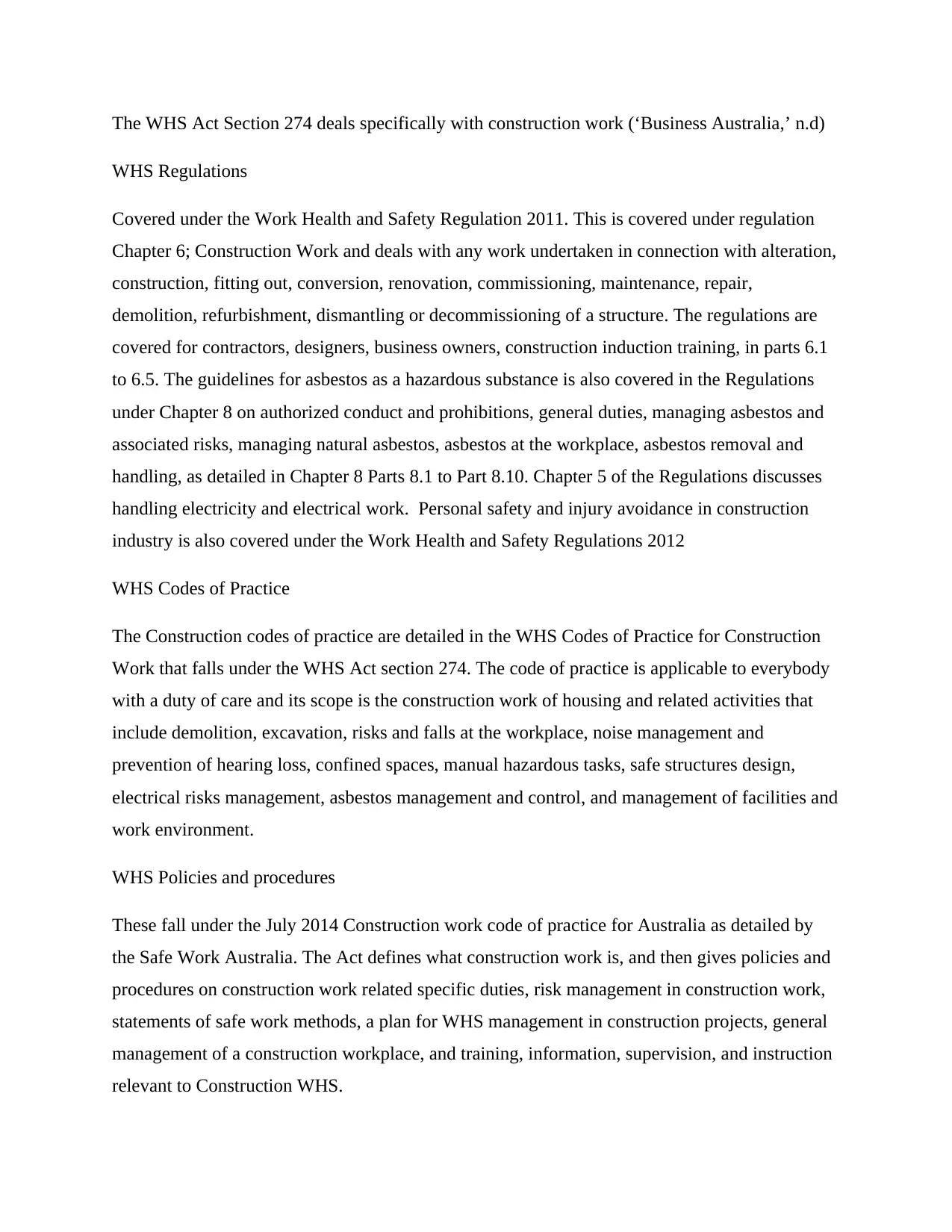
The WHS Act Section 274 deals specifically with construction work (‘Business Australia,’ n.d)
WHS Regulations
Covered under the Work Health and Safety Regulation 2011. This is covered under regulation
Chapter 6; Construction Work and deals with any work undertaken in connection with alteration,
construction, fitting out, conversion, renovation, commissioning, maintenance, repair,
demolition, refurbishment, dismantling or decommissioning of a structure. The regulations are
covered for contractors, designers, business owners, construction induction training, in parts 6.1
to 6.5. The guidelines for asbestos as a hazardous substance is also covered in the Regulations
under Chapter 8 on authorized conduct and prohibitions, general duties, managing asbestos and
associated risks, managing natural asbestos, asbestos at the workplace, asbestos removal and
handling, as detailed in Chapter 8 Parts 8.1 to Part 8.10. Chapter 5 of the Regulations discusses
handling electricity and electrical work. Personal safety and injury avoidance in construction
industry is also covered under the Work Health and Safety Regulations 2012
WHS Codes of Practice
The Construction codes of practice are detailed in the WHS Codes of Practice for Construction
Work that falls under the WHS Act section 274. The code of practice is applicable to everybody
with a duty of care and its scope is the construction work of housing and related activities that
include demolition, excavation, risks and falls at the workplace, noise management and
prevention of hearing loss, confined spaces, manual hazardous tasks, safe structures design,
electrical risks management, asbestos management and control, and management of facilities and
work environment.
WHS Policies and procedures
These fall under the July 2014 Construction work code of practice for Australia as detailed by
the Safe Work Australia. The Act defines what construction work is, and then gives policies and
procedures on construction work related specific duties, risk management in construction work,
statements of safe work methods, a plan for WHS management in construction projects, general
management of a construction workplace, and training, information, supervision, and instruction
relevant to Construction WHS.
WHS Regulations
Covered under the Work Health and Safety Regulation 2011. This is covered under regulation
Chapter 6; Construction Work and deals with any work undertaken in connection with alteration,
construction, fitting out, conversion, renovation, commissioning, maintenance, repair,
demolition, refurbishment, dismantling or decommissioning of a structure. The regulations are
covered for contractors, designers, business owners, construction induction training, in parts 6.1
to 6.5. The guidelines for asbestos as a hazardous substance is also covered in the Regulations
under Chapter 8 on authorized conduct and prohibitions, general duties, managing asbestos and
associated risks, managing natural asbestos, asbestos at the workplace, asbestos removal and
handling, as detailed in Chapter 8 Parts 8.1 to Part 8.10. Chapter 5 of the Regulations discusses
handling electricity and electrical work. Personal safety and injury avoidance in construction
industry is also covered under the Work Health and Safety Regulations 2012
WHS Codes of Practice
The Construction codes of practice are detailed in the WHS Codes of Practice for Construction
Work that falls under the WHS Act section 274. The code of practice is applicable to everybody
with a duty of care and its scope is the construction work of housing and related activities that
include demolition, excavation, risks and falls at the workplace, noise management and
prevention of hearing loss, confined spaces, manual hazardous tasks, safe structures design,
electrical risks management, asbestos management and control, and management of facilities and
work environment.
WHS Policies and procedures
These fall under the July 2014 Construction work code of practice for Australia as detailed by
the Safe Work Australia. The Act defines what construction work is, and then gives policies and
procedures on construction work related specific duties, risk management in construction work,
statements of safe work methods, a plan for WHS management in construction projects, general
management of a construction workplace, and training, information, supervision, and instruction
relevant to Construction WHS.
⊘ This is a preview!⊘
Do you want full access?
Subscribe today to unlock all pages.

Trusted by 1+ million students worldwide
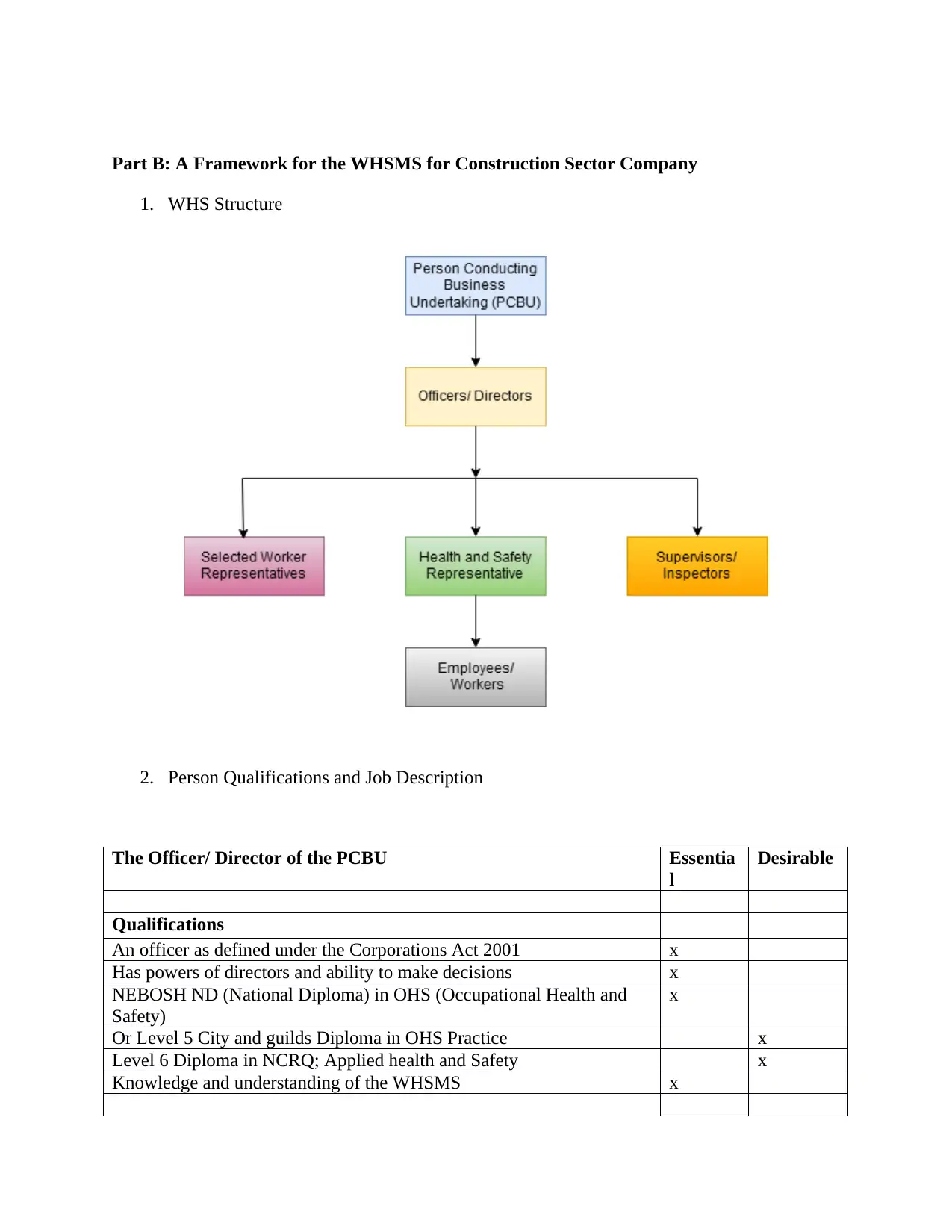
Part B: A Framework for the WHSMS for Construction Sector Company
1. WHS Structure
2. Person Qualifications and Job Description
The Officer/ Director of the PCBU Essentia
l
Desirable
Qualifications
An officer as defined under the Corporations Act 2001 x
Has powers of directors and ability to make decisions x
NEBOSH ND (National Diploma) in OHS (Occupational Health and
Safety)
x
Or Level 5 City and guilds Diploma in OHS Practice x
Level 6 Diploma in NCRQ; Applied health and Safety x
Knowledge and understanding of the WHSMS x
1. WHS Structure
2. Person Qualifications and Job Description
The Officer/ Director of the PCBU Essentia
l
Desirable
Qualifications
An officer as defined under the Corporations Act 2001 x
Has powers of directors and ability to make decisions x
NEBOSH ND (National Diploma) in OHS (Occupational Health and
Safety)
x
Or Level 5 City and guilds Diploma in OHS Practice x
Level 6 Diploma in NCRQ; Applied health and Safety x
Knowledge and understanding of the WHSMS x
Paraphrase This Document
Need a fresh take? Get an instant paraphrase of this document with our AI Paraphraser
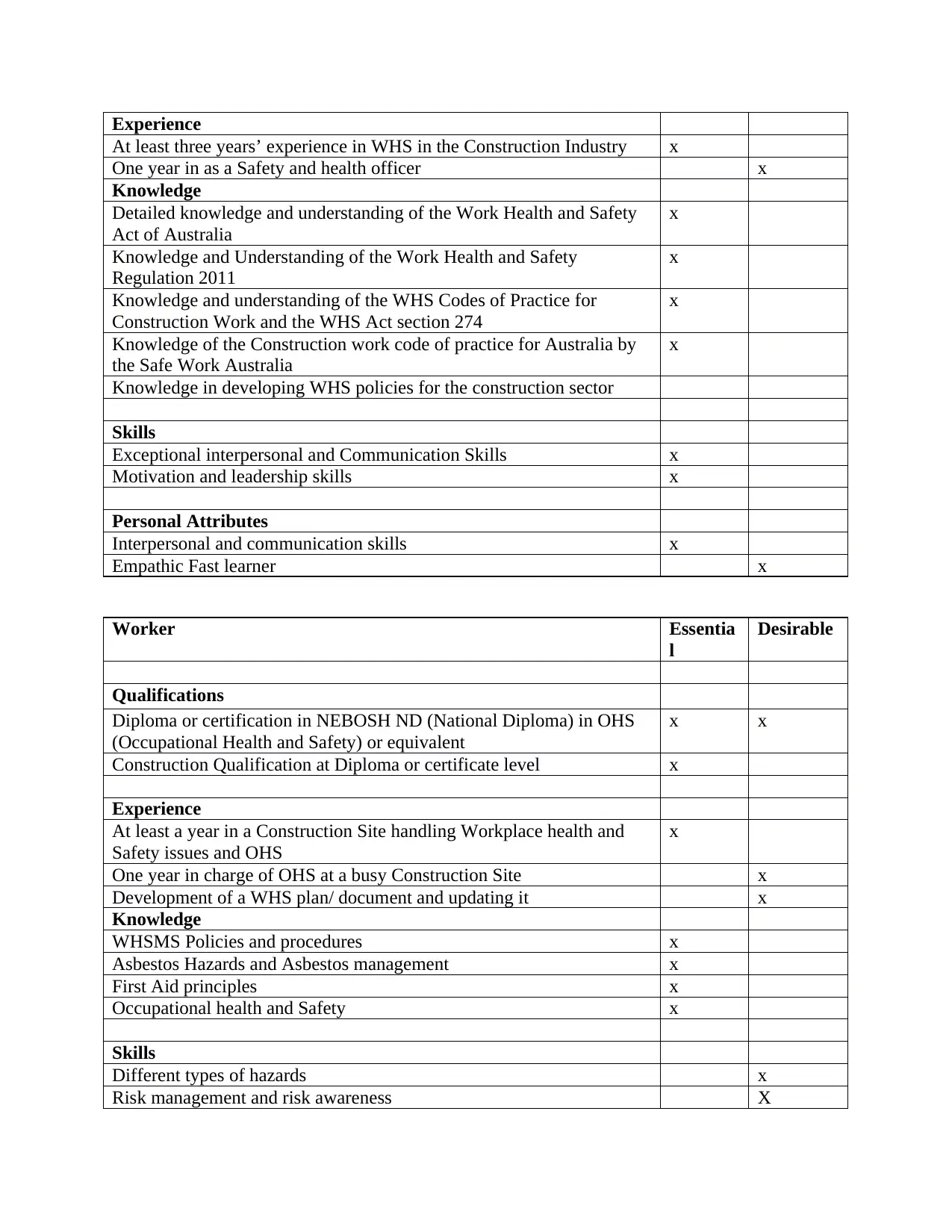
Experience
At least three years’ experience in WHS in the Construction Industry x
One year in as a Safety and health officer x
Knowledge
Detailed knowledge and understanding of the Work Health and Safety
Act of Australia
x
Knowledge and Understanding of the Work Health and Safety
Regulation 2011
x
Knowledge and understanding of the WHS Codes of Practice for
Construction Work and the WHS Act section 274
x
Knowledge of the Construction work code of practice for Australia by
the Safe Work Australia
x
Knowledge in developing WHS policies for the construction sector
Skills
Exceptional interpersonal and Communication Skills x
Motivation and leadership skills x
Personal Attributes
Interpersonal and communication skills x
Empathic Fast learner x
Worker Essentia
l
Desirable
Qualifications
Diploma or certification in NEBOSH ND (National Diploma) in OHS
(Occupational Health and Safety) or equivalent
x x
Construction Qualification at Diploma or certificate level x
Experience
At least a year in a Construction Site handling Workplace health and
Safety issues and OHS
x
One year in charge of OHS at a busy Construction Site x
Development of a WHS plan/ document and updating it x
Knowledge
WHSMS Policies and procedures x
Asbestos Hazards and Asbestos management x
First Aid principles x
Occupational health and Safety x
Skills
Different types of hazards x
Risk management and risk awareness X
At least three years’ experience in WHS in the Construction Industry x
One year in as a Safety and health officer x
Knowledge
Detailed knowledge and understanding of the Work Health and Safety
Act of Australia
x
Knowledge and Understanding of the Work Health and Safety
Regulation 2011
x
Knowledge and understanding of the WHS Codes of Practice for
Construction Work and the WHS Act section 274
x
Knowledge of the Construction work code of practice for Australia by
the Safe Work Australia
x
Knowledge in developing WHS policies for the construction sector
Skills
Exceptional interpersonal and Communication Skills x
Motivation and leadership skills x
Personal Attributes
Interpersonal and communication skills x
Empathic Fast learner x
Worker Essentia
l
Desirable
Qualifications
Diploma or certification in NEBOSH ND (National Diploma) in OHS
(Occupational Health and Safety) or equivalent
x x
Construction Qualification at Diploma or certificate level x
Experience
At least a year in a Construction Site handling Workplace health and
Safety issues and OHS
x
One year in charge of OHS at a busy Construction Site x
Development of a WHS plan/ document and updating it x
Knowledge
WHSMS Policies and procedures x
Asbestos Hazards and Asbestos management x
First Aid principles x
Occupational health and Safety x
Skills
Different types of hazards x
Risk management and risk awareness X
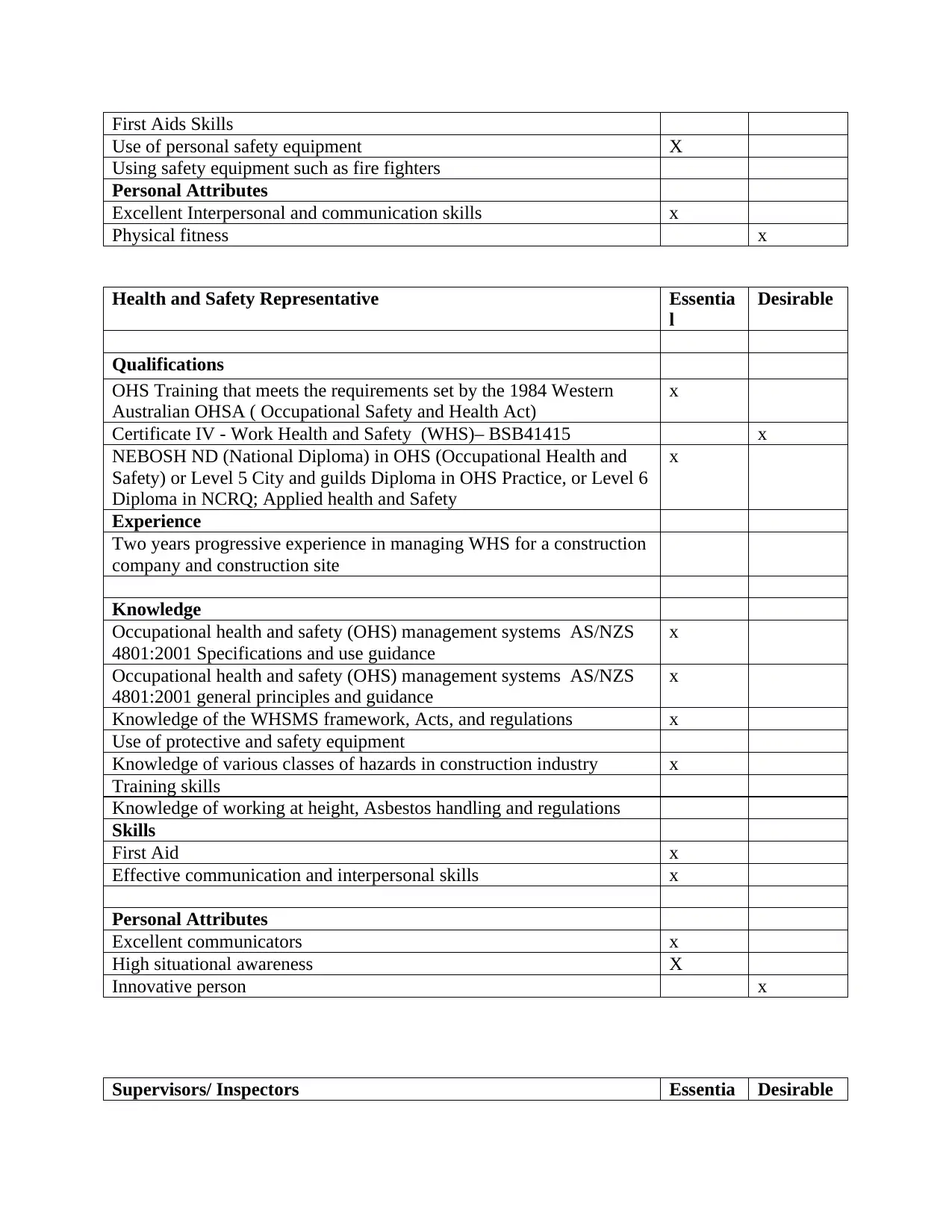
First Aids Skills
Use of personal safety equipment X
Using safety equipment such as fire fighters
Personal Attributes
Excellent Interpersonal and communication skills x
Physical fitness x
Health and Safety Representative Essentia
l
Desirable
Qualifications
OHS Training that meets the requirements set by the 1984 Western
Australian OHSA ( Occupational Safety and Health Act)
x
Certificate IV - Work Health and Safety (WHS)– BSB41415 x
NEBOSH ND (National Diploma) in OHS (Occupational Health and
Safety) or Level 5 City and guilds Diploma in OHS Practice, or Level 6
Diploma in NCRQ; Applied health and Safety
x
Experience
Two years progressive experience in managing WHS for a construction
company and construction site
Knowledge
Occupational health and safety (OHS) management systems AS/NZS
4801:2001 Specifications and use guidance
x
Occupational health and safety (OHS) management systems AS/NZS
4801:2001 general principles and guidance
x
Knowledge of the WHSMS framework, Acts, and regulations x
Use of protective and safety equipment
Knowledge of various classes of hazards in construction industry x
Training skills
Knowledge of working at height, Asbestos handling and regulations
Skills
First Aid x
Effective communication and interpersonal skills x
Personal Attributes
Excellent communicators x
High situational awareness X
Innovative person x
Supervisors/ Inspectors Essentia Desirable
Use of personal safety equipment X
Using safety equipment such as fire fighters
Personal Attributes
Excellent Interpersonal and communication skills x
Physical fitness x
Health and Safety Representative Essentia
l
Desirable
Qualifications
OHS Training that meets the requirements set by the 1984 Western
Australian OHSA ( Occupational Safety and Health Act)
x
Certificate IV - Work Health and Safety (WHS)– BSB41415 x
NEBOSH ND (National Diploma) in OHS (Occupational Health and
Safety) or Level 5 City and guilds Diploma in OHS Practice, or Level 6
Diploma in NCRQ; Applied health and Safety
x
Experience
Two years progressive experience in managing WHS for a construction
company and construction site
Knowledge
Occupational health and safety (OHS) management systems AS/NZS
4801:2001 Specifications and use guidance
x
Occupational health and safety (OHS) management systems AS/NZS
4801:2001 general principles and guidance
x
Knowledge of the WHSMS framework, Acts, and regulations x
Use of protective and safety equipment
Knowledge of various classes of hazards in construction industry x
Training skills
Knowledge of working at height, Asbestos handling and regulations
Skills
First Aid x
Effective communication and interpersonal skills x
Personal Attributes
Excellent communicators x
High situational awareness X
Innovative person x
Supervisors/ Inspectors Essentia Desirable
⊘ This is a preview!⊘
Do you want full access?
Subscribe today to unlock all pages.

Trusted by 1+ million students worldwide
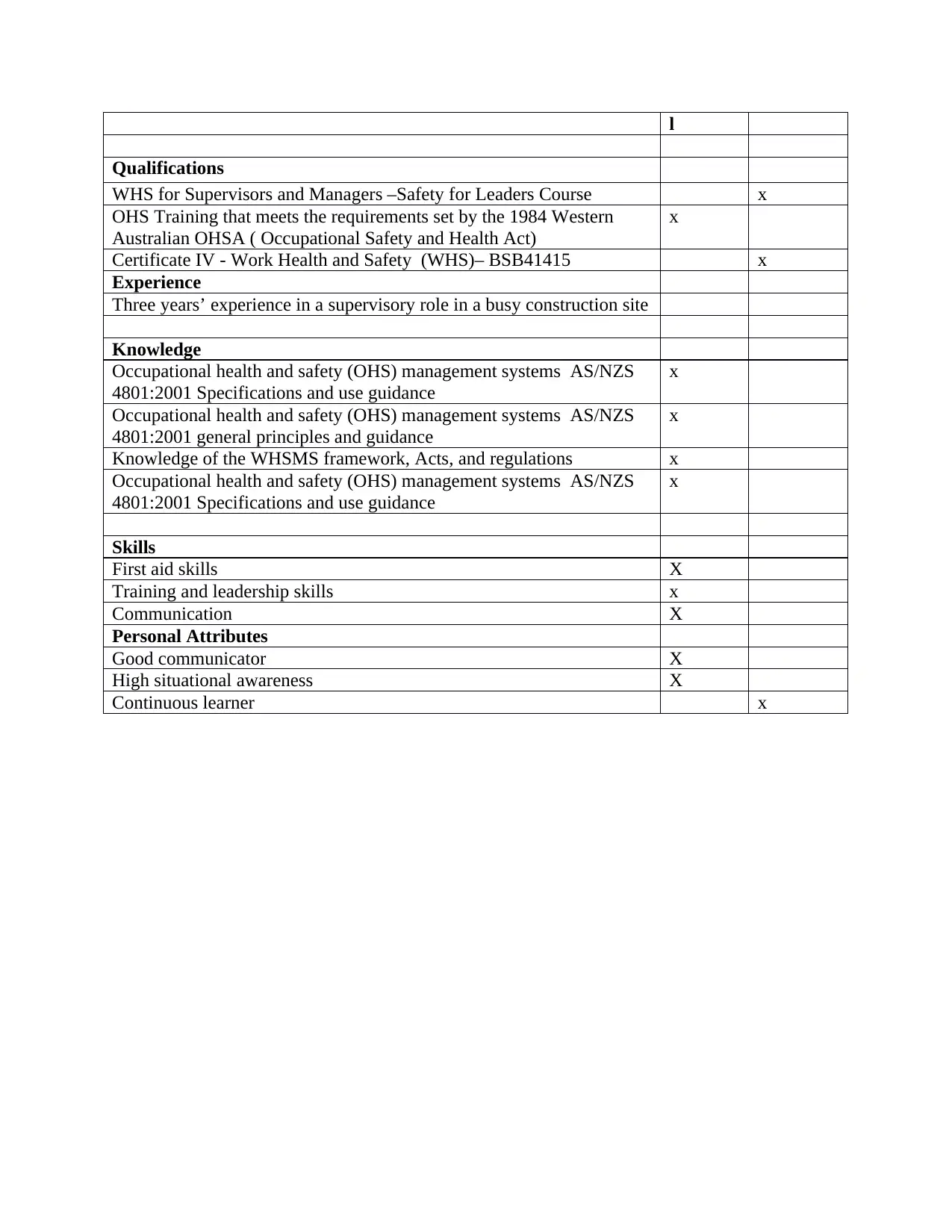
l
Qualifications
WHS for Supervisors and Managers –Safety for Leaders Course x
OHS Training that meets the requirements set by the 1984 Western
Australian OHSA ( Occupational Safety and Health Act)
x
Certificate IV - Work Health and Safety (WHS)– BSB41415 x
Experience
Three years’ experience in a supervisory role in a busy construction site
Knowledge
Occupational health and safety (OHS) management systems AS/NZS
4801:2001 Specifications and use guidance
x
Occupational health and safety (OHS) management systems AS/NZS
4801:2001 general principles and guidance
x
Knowledge of the WHSMS framework, Acts, and regulations x
Occupational health and safety (OHS) management systems AS/NZS
4801:2001 Specifications and use guidance
x
Skills
First aid skills X
Training and leadership skills x
Communication X
Personal Attributes
Good communicator X
High situational awareness X
Continuous learner x
Qualifications
WHS for Supervisors and Managers –Safety for Leaders Course x
OHS Training that meets the requirements set by the 1984 Western
Australian OHSA ( Occupational Safety and Health Act)
x
Certificate IV - Work Health and Safety (WHS)– BSB41415 x
Experience
Three years’ experience in a supervisory role in a busy construction site
Knowledge
Occupational health and safety (OHS) management systems AS/NZS
4801:2001 Specifications and use guidance
x
Occupational health and safety (OHS) management systems AS/NZS
4801:2001 general principles and guidance
x
Knowledge of the WHSMS framework, Acts, and regulations x
Occupational health and safety (OHS) management systems AS/NZS
4801:2001 Specifications and use guidance
x
Skills
First aid skills X
Training and leadership skills x
Communication X
Personal Attributes
Good communicator X
High situational awareness X
Continuous learner x
Paraphrase This Document
Need a fresh take? Get an instant paraphrase of this document with our AI Paraphraser
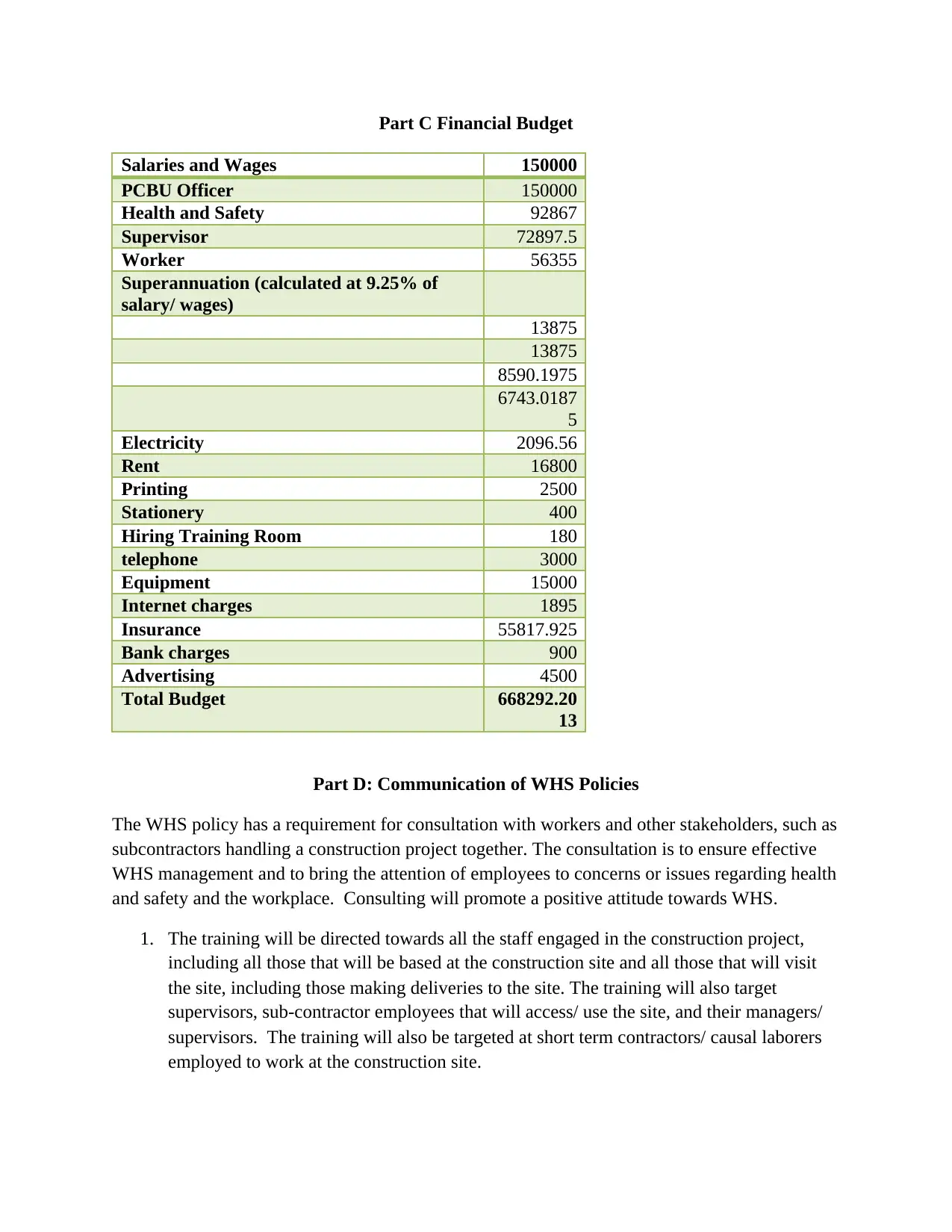
Part C Financial Budget
Salaries and Wages 150000
PCBU Officer 150000
Health and Safety 92867
Supervisor 72897.5
Worker 56355
Superannuation (calculated at 9.25% of
salary/ wages)
13875
13875
8590.1975
6743.0187
5
Electricity 2096.56
Rent 16800
Printing 2500
Stationery 400
Hiring Training Room 180
telephone 3000
Equipment 15000
Internet charges 1895
Insurance 55817.925
Bank charges 900
Advertising 4500
Total Budget 668292.20
13
Part D: Communication of WHS Policies
The WHS policy has a requirement for consultation with workers and other stakeholders, such as
subcontractors handling a construction project together. The consultation is to ensure effective
WHS management and to bring the attention of employees to concerns or issues regarding health
and safety and the workplace. Consulting will promote a positive attitude towards WHS.
1. The training will be directed towards all the staff engaged in the construction project,
including all those that will be based at the construction site and all those that will visit
the site, including those making deliveries to the site. The training will also target
supervisors, sub-contractor employees that will access/ use the site, and their managers/
supervisors. The training will also be targeted at short term contractors/ causal laborers
employed to work at the construction site.
Salaries and Wages 150000
PCBU Officer 150000
Health and Safety 92867
Supervisor 72897.5
Worker 56355
Superannuation (calculated at 9.25% of
salary/ wages)
13875
13875
8590.1975
6743.0187
5
Electricity 2096.56
Rent 16800
Printing 2500
Stationery 400
Hiring Training Room 180
telephone 3000
Equipment 15000
Internet charges 1895
Insurance 55817.925
Bank charges 900
Advertising 4500
Total Budget 668292.20
13
Part D: Communication of WHS Policies
The WHS policy has a requirement for consultation with workers and other stakeholders, such as
subcontractors handling a construction project together. The consultation is to ensure effective
WHS management and to bring the attention of employees to concerns or issues regarding health
and safety and the workplace. Consulting will promote a positive attitude towards WHS.
1. The training will be directed towards all the staff engaged in the construction project,
including all those that will be based at the construction site and all those that will visit
the site, including those making deliveries to the site. The training will also target
supervisors, sub-contractor employees that will access/ use the site, and their managers/
supervisors. The training will also be targeted at short term contractors/ causal laborers
employed to work at the construction site.
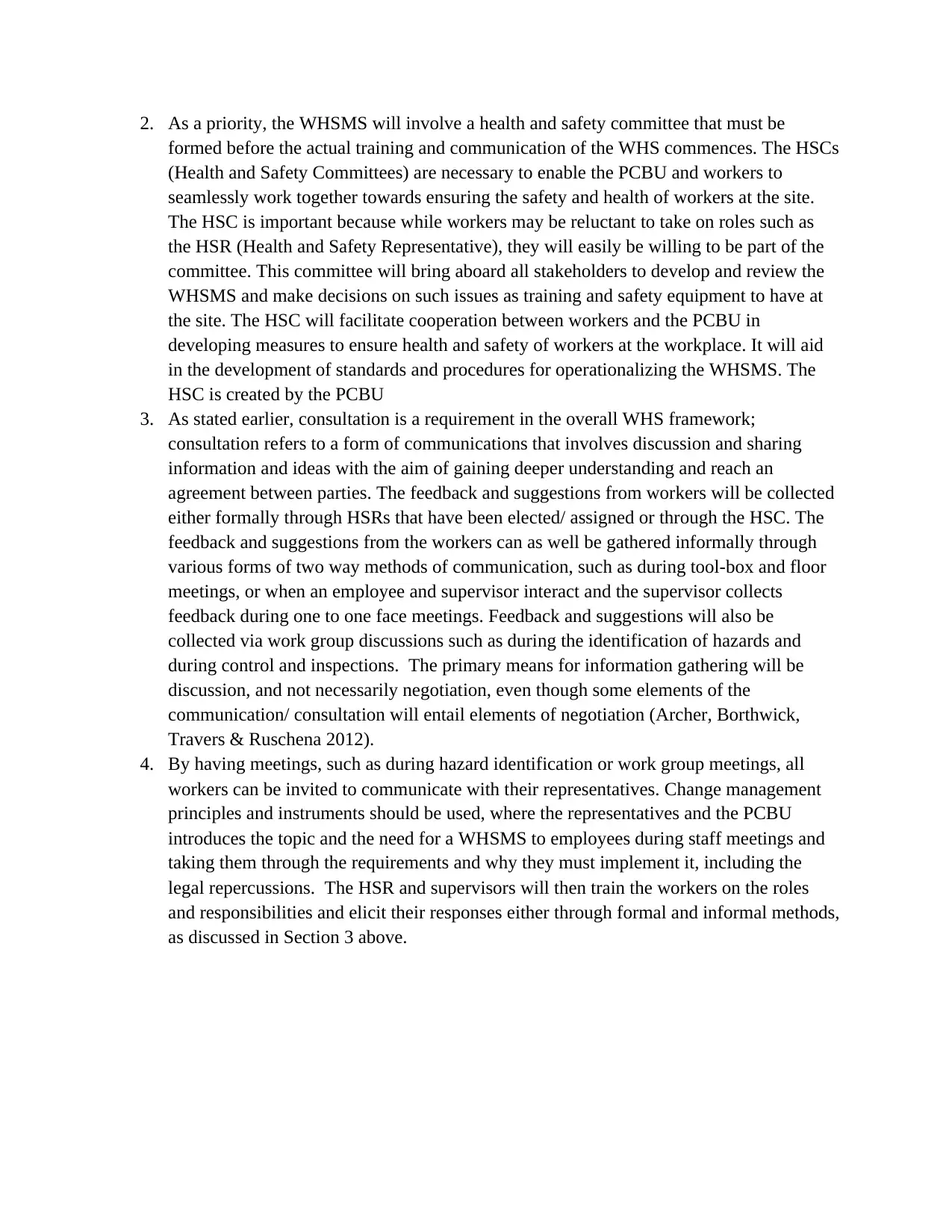
2. As a priority, the WHSMS will involve a health and safety committee that must be
formed before the actual training and communication of the WHS commences. The HSCs
(Health and Safety Committees) are necessary to enable the PCBU and workers to
seamlessly work together towards ensuring the safety and health of workers at the site.
The HSC is important because while workers may be reluctant to take on roles such as
the HSR (Health and Safety Representative), they will easily be willing to be part of the
committee. This committee will bring aboard all stakeholders to develop and review the
WHSMS and make decisions on such issues as training and safety equipment to have at
the site. The HSC will facilitate cooperation between workers and the PCBU in
developing measures to ensure health and safety of workers at the workplace. It will aid
in the development of standards and procedures for operationalizing the WHSMS. The
HSC is created by the PCBU
3. As stated earlier, consultation is a requirement in the overall WHS framework;
consultation refers to a form of communications that involves discussion and sharing
information and ideas with the aim of gaining deeper understanding and reach an
agreement between parties. The feedback and suggestions from workers will be collected
either formally through HSRs that have been elected/ assigned or through the HSC. The
feedback and suggestions from the workers can as well be gathered informally through
various forms of two way methods of communication, such as during tool-box and floor
meetings, or when an employee and supervisor interact and the supervisor collects
feedback during one to one face meetings. Feedback and suggestions will also be
collected via work group discussions such as during the identification of hazards and
during control and inspections. The primary means for information gathering will be
discussion, and not necessarily negotiation, even though some elements of the
communication/ consultation will entail elements of negotiation (Archer, Borthwick,
Travers & Ruschena 2012).
4. By having meetings, such as during hazard identification or work group meetings, all
workers can be invited to communicate with their representatives. Change management
principles and instruments should be used, where the representatives and the PCBU
introduces the topic and the need for a WHSMS to employees during staff meetings and
taking them through the requirements and why they must implement it, including the
legal repercussions. The HSR and supervisors will then train the workers on the roles
and responsibilities and elicit their responses either through formal and informal methods,
as discussed in Section 3 above.
formed before the actual training and communication of the WHS commences. The HSCs
(Health and Safety Committees) are necessary to enable the PCBU and workers to
seamlessly work together towards ensuring the safety and health of workers at the site.
The HSC is important because while workers may be reluctant to take on roles such as
the HSR (Health and Safety Representative), they will easily be willing to be part of the
committee. This committee will bring aboard all stakeholders to develop and review the
WHSMS and make decisions on such issues as training and safety equipment to have at
the site. The HSC will facilitate cooperation between workers and the PCBU in
developing measures to ensure health and safety of workers at the workplace. It will aid
in the development of standards and procedures for operationalizing the WHSMS. The
HSC is created by the PCBU
3. As stated earlier, consultation is a requirement in the overall WHS framework;
consultation refers to a form of communications that involves discussion and sharing
information and ideas with the aim of gaining deeper understanding and reach an
agreement between parties. The feedback and suggestions from workers will be collected
either formally through HSRs that have been elected/ assigned or through the HSC. The
feedback and suggestions from the workers can as well be gathered informally through
various forms of two way methods of communication, such as during tool-box and floor
meetings, or when an employee and supervisor interact and the supervisor collects
feedback during one to one face meetings. Feedback and suggestions will also be
collected via work group discussions such as during the identification of hazards and
during control and inspections. The primary means for information gathering will be
discussion, and not necessarily negotiation, even though some elements of the
communication/ consultation will entail elements of negotiation (Archer, Borthwick,
Travers & Ruschena 2012).
4. By having meetings, such as during hazard identification or work group meetings, all
workers can be invited to communicate with their representatives. Change management
principles and instruments should be used, where the representatives and the PCBU
introduces the topic and the need for a WHSMS to employees during staff meetings and
taking them through the requirements and why they must implement it, including the
legal repercussions. The HSR and supervisors will then train the workers on the roles
and responsibilities and elicit their responses either through formal and informal methods,
as discussed in Section 3 above.
⊘ This is a preview!⊘
Do you want full access?
Subscribe today to unlock all pages.

Trusted by 1+ million students worldwide
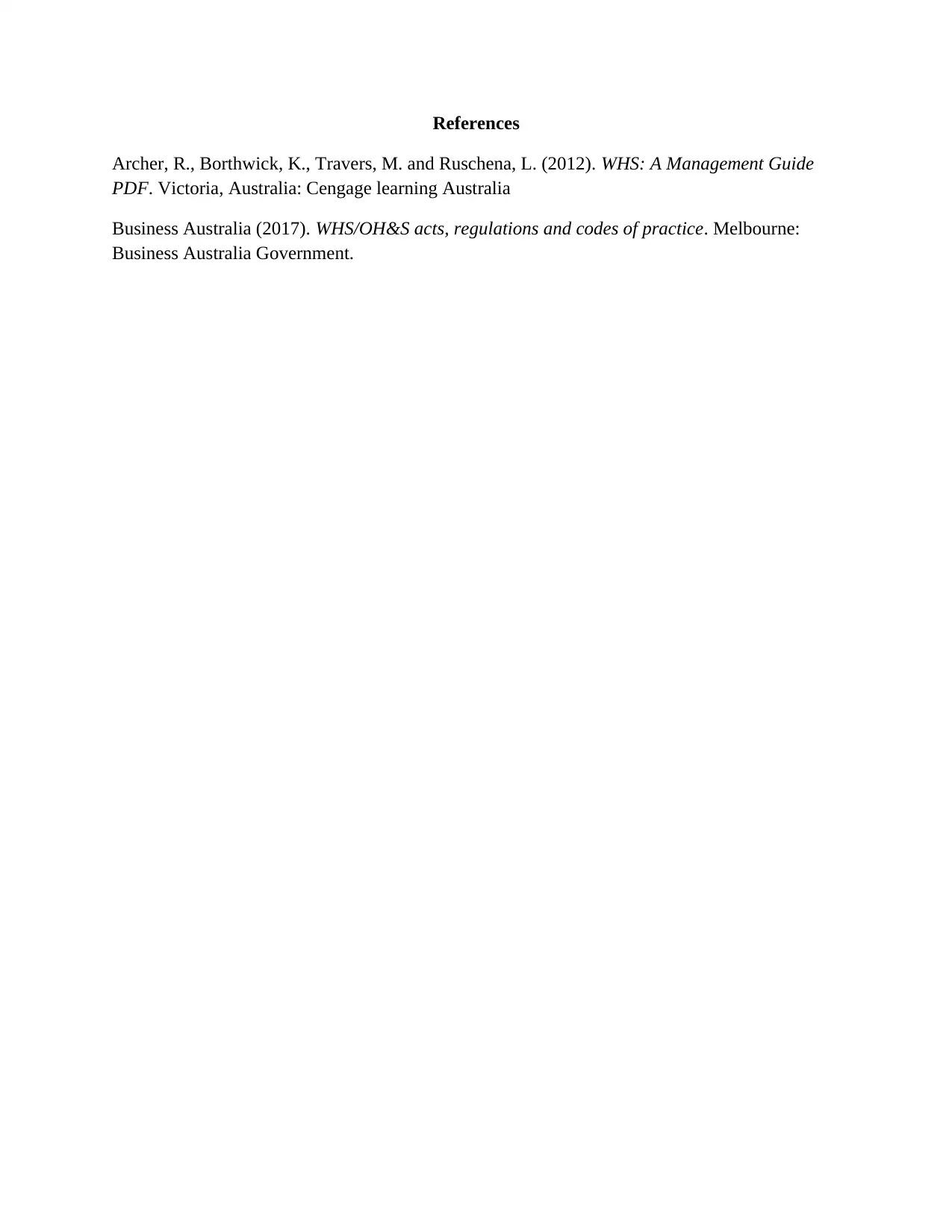
References
Archer, R., Borthwick, K., Travers, M. and Ruschena, L. (2012). WHS: A Management Guide
PDF. Victoria, Australia: Cengage learning Australia
Business Australia (2017). WHS/OH&S acts, regulations and codes of practice. Melbourne:
Business Australia Government.
Archer, R., Borthwick, K., Travers, M. and Ruschena, L. (2012). WHS: A Management Guide
PDF. Victoria, Australia: Cengage learning Australia
Business Australia (2017). WHS/OH&S acts, regulations and codes of practice. Melbourne:
Business Australia Government.
1 out of 10
Related Documents
Your All-in-One AI-Powered Toolkit for Academic Success.
+13062052269
info@desklib.com
Available 24*7 on WhatsApp / Email
![[object Object]](/_next/static/media/star-bottom.7253800d.svg)
Unlock your academic potential
Copyright © 2020–2025 A2Z Services. All Rights Reserved. Developed and managed by ZUCOL.




